Suppose that we are in an area with no electricity. With this 5V 2A buck converter circuit, we can charge our mobile phone with a 10W solar cell that can supply a current of approximately 0.5A and a voltage of 17V to 21V.
It can supply a voltage of 5V and a current of 0.6A to 1.8A to charge our phone with just the solar cell that we have.
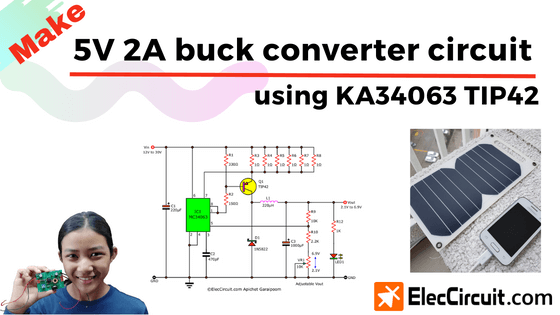
This block diagram below will help you visualize the order of operation more easily.

The buck converter can convert almost the same amount of power. In practice, its output may be reduced to 9W, which results in us having to wait longer to charge the battery.
However, this loss rate is acceptable because it is very low.
Simple MC34063 Buck converter circuit
We use MC34063 or KA34063 as the main component in these circuits. It is not the best SMPS (Switching Mode Power Supply) IC. But it is widely used enough to be found easily on the market.
They are now very cheap and are starting to make their way into the hobby world. We often see them in 12V to 5V converter circuits used in cars.
At a current below 1A, no external drivers are required, and the circuit is very simple to build.
The chip can be used in a buck or boost converters, inverting circuits, etc. It is therefore a good IC to replace LM317.
You should have it stocked up for when creating various switching-mode power supplies; it will become useful.
It is both shaped and easy to use, like a 555 timer chip.
Here we will look into a simple step-down buck converter for 500mA, As you can see, there are very few required components.
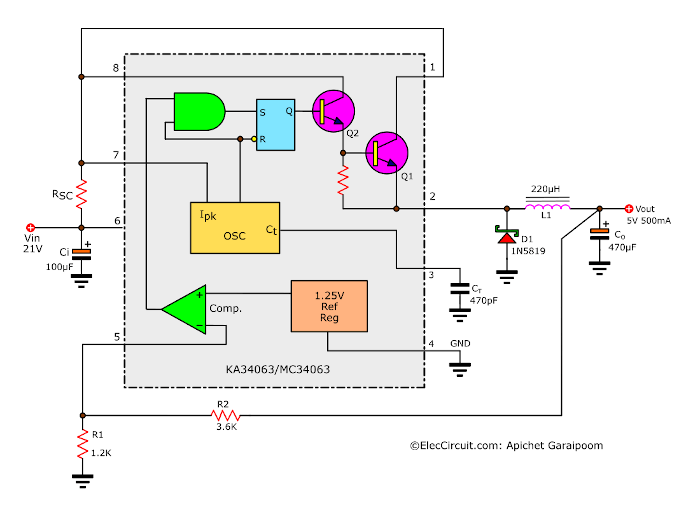
We will briefly learn it first, just enough for us to use it. In the future, my daughter and I will learn more deeply about it, and we will tell you more about that experience.
If you are a beginner, you should learn the working principle of a basic buck converter first.
But to put it simply, it consists of Ci, Co, L1, D1, and the switching system, which is inside the chip.
Look Inside
Its switching system comprises several parts.
Q1 and Q2 are transistors run as switches at high frequencies, controlled through RS flip-flops generated by an oscillator (OSC).
The OSC’s frequency is determined by CT at pin 3. In the datasheet, it is suggested that CT be 470pF, while pin 3 measures approximately 30kHz at no load.
The output voltage is determined by R1 and R2, whose values can be calculated by the following formula:
Vout = 1.25 V x {1 + R2/R1}.
It uses the same formula as the LM317, and its internal structure also has the 1.25V reference voltage and the comparator.In the block diagram, the comparators’ output is connected to the AND gates’ input.
RSC is a max-current limit resistor, and by limiting the maximum current, we can ensure the safety of the circuit and increase the efficiency of oscillation. The RSC is placed between pin 6 (Vin) and pin 7 to limit the inductors’ maximum current.In this case, the RSC is 0.3 ohms, as it will limit the current at 1A through the formula 0.3V/0.3 = 1A. But at normal operating efficiency, it can only power about 0.5 A of current.
Increasing current with PNP Transistor
By adding a transistor, we can amplify the current higher. According to its datasheet, we can use both NPN and PNP transistors, but we should use PNP transistors instead because it has higher efficiency.
We’ve also added R1 and R2 to help optimise the bias current. As for the transistor, we chose the TIP42 because its datasheet says that it can drive current up to 6A.
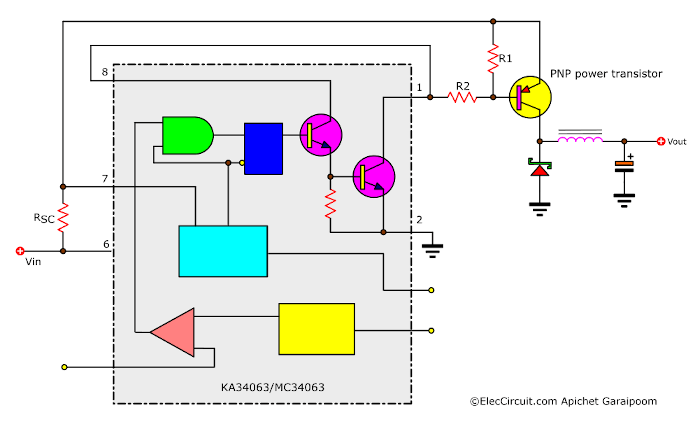
Through our experiments, we can infer that we can increase the current to approximately 2A, with R1’s and R2’s values being 330Ω and 150Ω, respectively.
5V 2A Buck converter circuit
And finally, let us take a look at our complete circuit below.
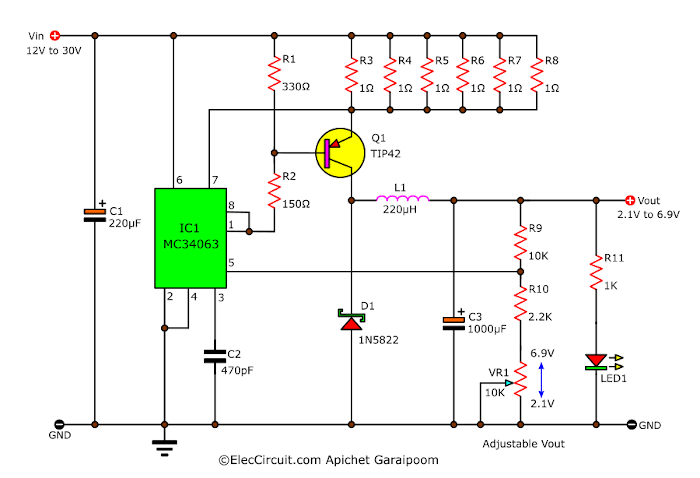
Which has additional details as follows:
L1 (inductor): we use a size of 220uH that can withstand a current of 3A. You should not be using anything lower than this because it causes the current to decrease.
C3 (CO-output capacitor): we use 1,000µF at 16V to reduce the output ripple voltage to approximately 30mV or less. Do not use one with a capacity lower than this, as it will reduce the output voltage when using a high-current load.
C1 (Ci-input capacitor): we use 220µF at 35V; it’s improves the efficiency of the circuit. When the input voltage fluctuates rapidly. It should keep the DC working voltage (WVDC) at least 35V because we use an input voltage of 30V maximum.
C2 (Ct): we use the original value of 470pF.
D1: We use 1N5822 because it can withstand a high current of 3A, enough for our use here of 2A.
RSC (Max Current Limit Resistor)
When we set the maximum current at 2A. The RSC’s resistance is calculated to be 0.15Ω. But we currently do not have a resistor of that value.
So we connect six 1Ω resistors in parallel until we get the total resistance of 0.17Ω.
When rechecking our work, it shows that with our current setup, the max current is 1.76A; according to this formula, 0.3V/0.17Ω = 1.76A. Which is enough to charge the battery.
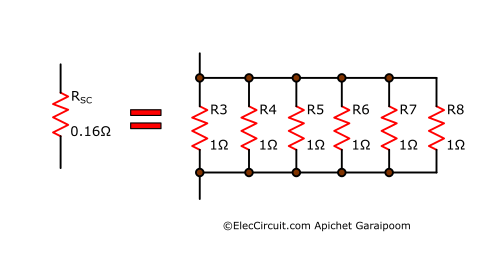
In the circuit, the RSC is R3 to R8.
Set the Output Voltage
We want the output voltage to be exactly 5V. From the formula given by the manufacturer, Vout = 1.25 V x {1 + R2/R1}.
But this only resulted in a constant output, so if we want it to be adjustable, we simply need to add variables in the form of a potentiometer in series, as shown in the illustration below.
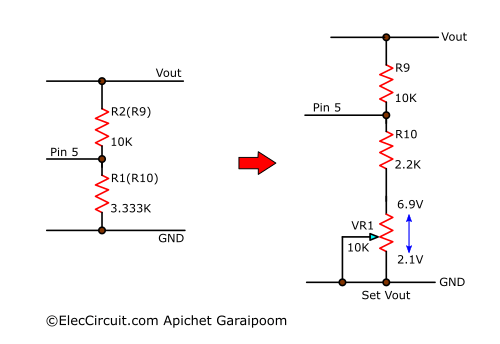
Allowing the Vout to be adjusted to any voltage in the range of 2.1V to 6.9V.
So now this circuit can be anything from a 3V Buck Converter Circuit to a 6V or even a 4.5V 2A Switching Regulator Circuit just by tweaking VR1.
Building 5V 2A Buck converter circuit
This circuit only has a few components, and they are all easy to find.
Components List
Resistors; 0.25W or 0.5W, 5% tolerance
- R1: 330Ω
- R2: 150Ω
- R3 to R8: 1Ω (8 pcs.)
- R9: 10K
- R10: 2.2K
- R11: 1K
- VR1: 100K Trimmer Potentiometer
Capacitors:
- C1: 220µF 50V, Electrolytic
- C3: 1,000µF 16V, Electrolytic
- C2: 470pF 50V. Ceramic
Semiconductors and others:
- IC1: KA34063 or equivalent, Boost/Buck DC/DC Converter/ Switching Regulator
- Q1: TIP42 or equivalent, 100V 6A transistor
- D1: 1N5822, 40V 3A, Schottky Barrier Diode
- ZD1: 5.1V 500mA or 1W, Zener Diode
- LED1: 3mm Red LED
- L1: 220µH inductor coil at 3A current
- 5x7cm Perforated PCB
Now we assemble each component into the perforated PCB and wire them together in the same layout shown below.
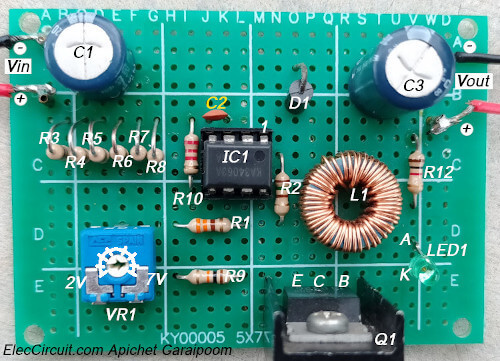
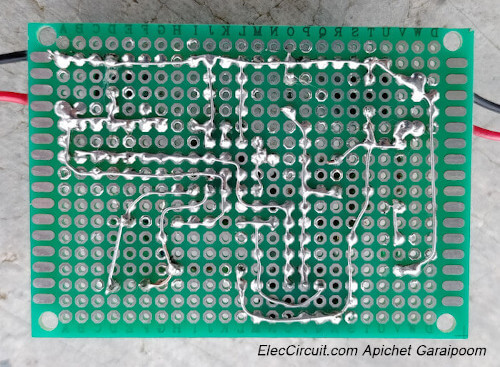
Testing the circuit
We will be testing the circuit with a DC power supply supplying 21V 0.5A instead of the intended solar cell panel because it is easier to control and monitor.
Then we use a 470 ohms 2W resistor as a load with the setup shown below.
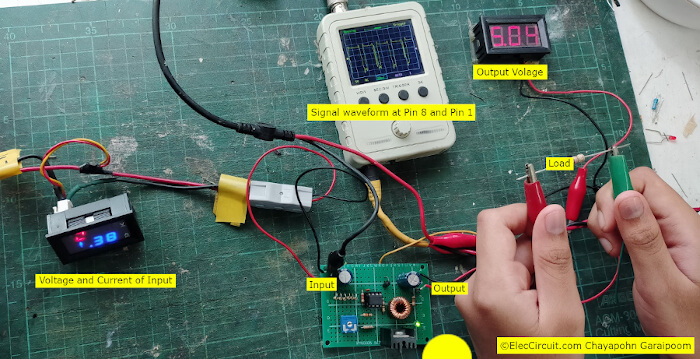
The output voltage remained at around 5.04V, while the input is 21V 0.38A.
Note that when we measure the frequency between pin 8 and pin 1, we see that it is in almost square-wave form with a frequency of about 30kHz. However, when the load’s size increases, the frequency will go up to 150kHz.
Now we try changing the load to one that requires 1.8A of current. And as shown below, the output voltage drops to 5.00V and the input current increases to 0.59A.
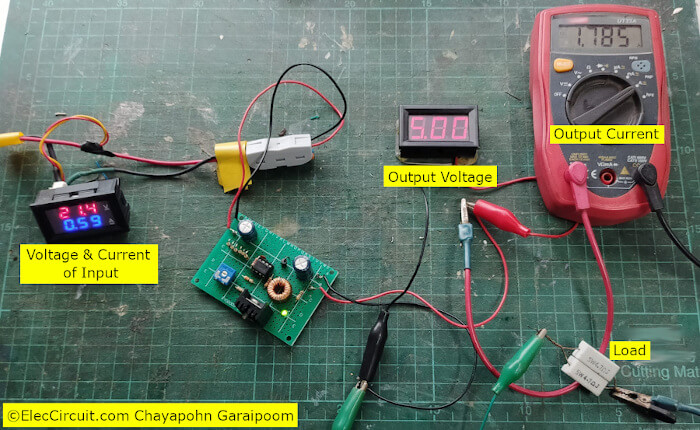
We may summarize both runs in a comparative table.
| Vin | Current in | Power in | Vout | Current-out | P-out | Efficiency % |
| 21V | 0.28A | 5.88W | 5.04V | 0.92A | 4.63W | 78.7% |
| 21V | 0.59A | 12.39W | 5V | 1.78A | 8.9W | 71.8% |
Theoretically speaking, it should have a higher efficiency of around 90% or even more. But this might be affected by components such as inductors, MOSFETs, etc.
Conclusion
We tested this circuit several times, and it worked quite well. The output voltage remains constant at 5V with a maximum current of about 2A.
However, the input current must be greater than 0.6A at a voltage of about 20V.
If our solar panel receives full sunlight for about 3 to 4 hours, it can fully charge our mobile phone.
In the future, we might use this Buck converter again. But especially for a larger load like a water pump, which needs 12V 40W, whereas our solar cell could supply a maximum of 21V 40W.
Which should not be connected directly because the voltage is too high.
Download This
All full-size images and PDFs of this post are in this Ebook below. Please support me. 🙂
GET UPDATE VIA EMAIL
I always try to make Electronics Learning Easy.
Related Posts

I love electronics. I have been learning about them through creating simple electronic circuits or small projects. And now I am also having my children do the same. Nevertheless, I hope you found the experiences we shared on this site useful and fulfilling.
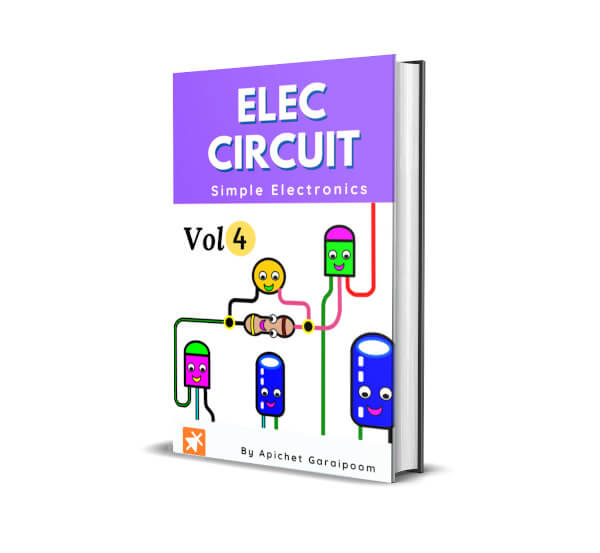
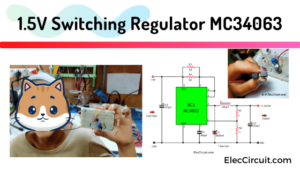
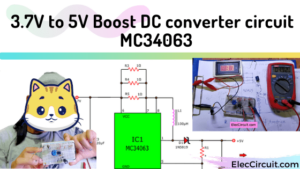
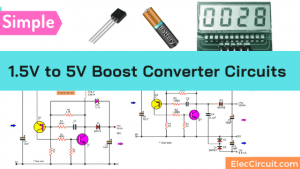
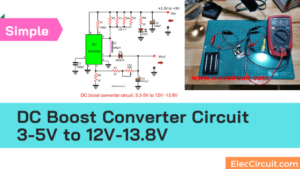
Practically useful gadget.
Hi,
You’re welcome.
Hope you will continue to follow us.🌷🙏
Very informative, neatly explained, easy to follow, thank you
Hi,
With great pleasure me and my dad Very happy to see that you like it. We will keep improving it. Hope you will continue to follow us. 🧡
Thank you for the enlightenment.I wish to try this project out .
Hi,
My pleasure. It’s great that you will try this circuit. It can power the current quite well. I and my father would like to add more of the current. But we didn’t have enough free time to try it out. It might add another transistor or MOSFET. It would be fun to try that. What do you think? 🤔